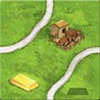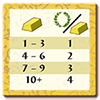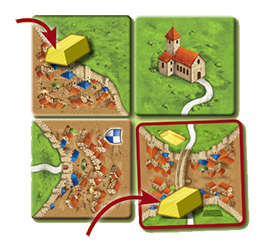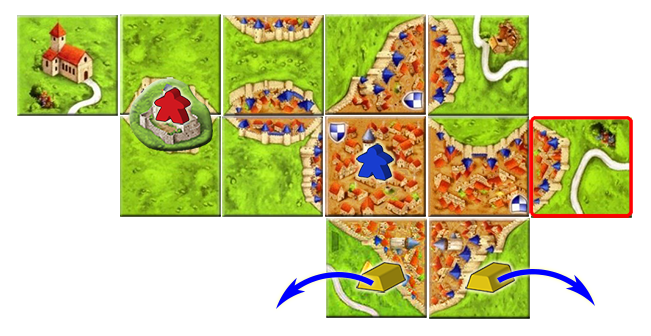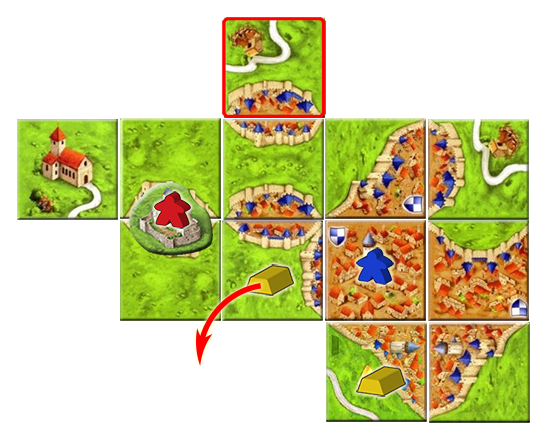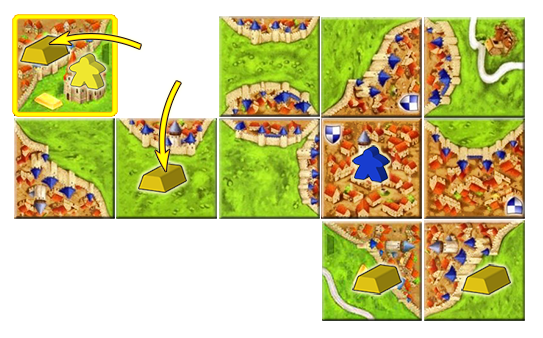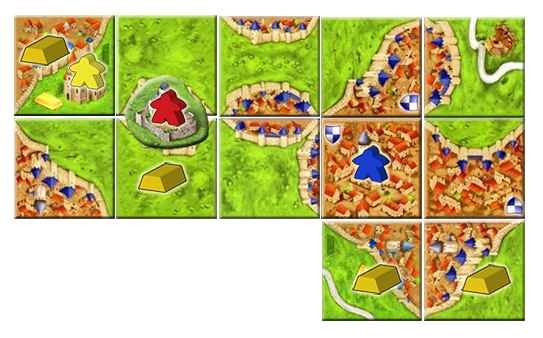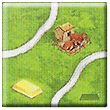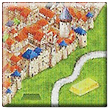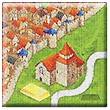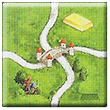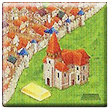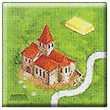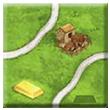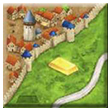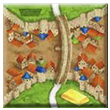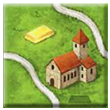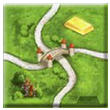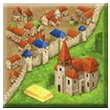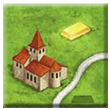De Goudmijnen
Algemene informatie en opmerkingen
De tweede editie, kortweg C2 genoemd, van De Goudmijnen (Mini #4) werd in 2017 uitgegeven door HiG en maakt deel uit van Big Box 6. Een derde editie, kortweg C3 genoemd, werd in 2021 uitgebracht en bevat gedetailleerdere illustraties, steden met afgekapte gebouwen en enkele kleine veranderingen in de bewoording. De C3 versie van deze uitbreiding is alleen verkrijgbaar als onderdeel van Big Box 7.
Deze uitbreiding werd oorspronkelijk in 2012 uitgegeven in een eerste editie, kortweg C1 genoemd.
Speelmateriaal
Spelregels
Voorbereiding
Schud de nieuwe landtegels door die van het basisspel en leg ze zoals gebruikelijk in gedekte stapels. Leg de goudstaven klaar voor gebruik.
Spelverloop
1. Landtegel leggen
2. Een meeple zetten
Na het leggen van de goudstaven mag je zoals gebruikelijk een meeple zetten.
3. Puntentellingen afhandelen
Als je een project afbouwt met één of meer goudstaven op de tegels waaruit het bestaat, dan worden deze verdeeld. De speler met de meerderheid in het afgebouwde project krijgt alle goudstaven die op te betreffende tegels liggen. Voor wegen en steden gaat het om alle tegels die ten minste een deel van het afgebouwde project tonen. Gaat het om een klooster, dan horen het klooster zelf en de 8 omringende tegels erbij. [1] [2] [3]
Gelijke stand: Als meerdere spelers de meerderheid in een afgebouwd project met goudstaven op één of meer van de tegels hebben, of als er meerdere projecten met goudstaven tegelijkertijd afgebouwd worden en ze van verschillende spelers zijn, vindt de verdeling als volgt plaats: te beginnen met de speler die aan de beurt is en daarna met de klok mee neemt iedere speler die op enige manier recht op een goudstaaf heeft één goudstaf van het project waar hij de meerderheid heeft. Dit gaat zolang door totdat alle goudstaven van de afgebouwde projecten genomen zijn. [4] [5]
De spelers leggen hun goudstaven voor de rest van het spel open voor zich op tafel. Goudstaven worden geteld bij de eindtelling. [6]
Eindtelling
Doe goud dat aan het einde van het spel nog op het speelveld ligt (die nog niet door een speler zijn verzameld) terug in de doos. Boeren krijgen geen goudstaven.
Na de eindtelling, krijgt iedere speler punten voor zijn goudstaven. Hoe meer goudstaven een speler heeft verzameld, des te meer is elke afzonderlijke goudstaaf waard. Tel het aantal goudstaven dat je verzameld hebt en kijk in onderstaande tabel om te zien hoeveel punten elke goudstaaf waard is. De tabel staat ook weergegeven op de overzichtstegel.
Samenvatting van de volgorde
Bij het spelen met De Goudmijnen, is de beurtvolgorde als volgt:
- 1. Landtegel leggen
- 2. Twee goudstaven leggen
- 3. Een meeple zetten
- 4. Puntentellingen afhandelen
- 5. Goudstaven verdelen
Andere uitbreidingen
If playing with other expansions, please take the following notes into consideration:
![]() Uitbr. 8 - Bruggen, Burchten & Bazaars
Uitbr. 8 - Bruggen, Burchten & Bazaars
![]() Exp. 8 - Bruggen, Burchten & Bazaars:
Exp. 8 - Bruggen, Burchten & Bazaars:
-
 Een burchtheer kan goudstaven verzamelen die in het leengoed van de burcht liggen. Het maakt niet uit dat de goudstaven niet op tegels liggen die bij het project horen dat de telling van de burcht veroorzaakte.
Een burchtheer kan goudstaven verzamelen die in het leengoed van de burcht liggen. Het maakt niet uit dat de goudstaven niet op tegels liggen die bij het project horen dat de telling van de burcht veroorzaakte.
![]() Vraag: Kan een burcht goudstaven verzamelen die op het leengoed liggen zoals een klooster goudstaven verzamelt die op de kloostertegel en alle omliggende tegels liggen?
Vraag: Kan een burcht goudstaven verzamelen die op het leengoed liggen zoals een klooster goudstaven verzamelt die op de kloostertegel en alle omliggende tegels liggen?
Antwoord: Een burcht kan ook goudstaven verzamelen, die welke op het leengoed van de burcht liggen. Het leengoed bestaat uit 6 tegels: de twee waarop de burcht gebouwd is, de twee rechts daarvan en de twee links daarvan. De burchtheer kan deze goudstaven pakken.
Als er meerdere spelers recht hebben op goudstaven, wordt het goud één voor één verdeeld, zoals beschreven in de spelregels. (6/2013)
- De volgende voorbeelden illustreren hoe goudstaven verdeeld worden in enkele scenario's waarbij burchten betrokken zijn: [7]
- Bij het tellen van een burcht kan de eigenaar alleen goudstaven verzamelen die op het leengoed van de burcht liggen. Goudstaven die op tegels buiten het leengoed van de burcht liggen, komen niet in aanmerking, ook al horen ze bij het project dat de telling van de burcht veroorzaakt heeft.
- De spelers nemen om beurten in aanmerking komende goudstaven die op tegels liggen van de projecten die geteld worden. Afhankelijk van de gevolgde volgorde, kunnen sommige spelers met goudstaven die in aanmerking komen achter het net vissen.
- Voorbeeld 1: Het verkennen van verschillende volgordes
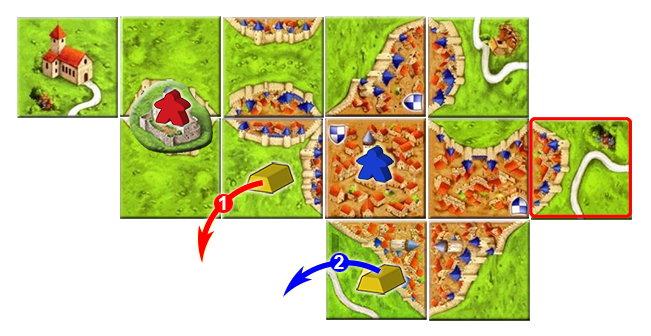 Voorbeeld 1A: Rood bouwt de stad van blauw af, waardoor de telling van de burcht van rood veroorzaakt wordt. Als actieve speler neemt rood eerst een goudstaaf, en dan blauw. Blauw kon ook aanspraak maken op de goudstaaf die rood nam (die lag zowel in het leengoed van de burcht, maar ook op een tegel met een stadsdeel van de stad van blauw), maar in dit geval was het voor rood de enige optie. Derhalve kan blauw alleen de goudstaaf onderin de stad pakken.
Voorbeeld 1A: Rood bouwt de stad van blauw af, waardoor de telling van de burcht van rood veroorzaakt wordt. Als actieve speler neemt rood eerst een goudstaaf, en dan blauw. Blauw kon ook aanspraak maken op de goudstaaf die rood nam (die lag zowel in het leengoed van de burcht, maar ook op een tegel met een stadsdeel van de stad van blauw), maar in dit geval was het voor rood de enige optie. Derhalve kan blauw alleen de goudstaaf onderin de stad pakken.
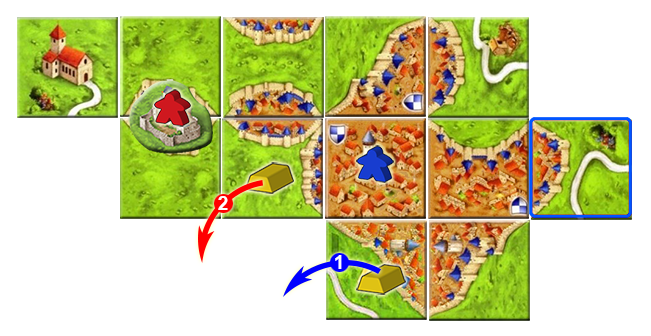 Voorbeeld 1B-1: Blauw bouwt haar stad af, want het tellen van de burcht van rood veroorzaakt. Als actieve speler neemt blauw eerst een goudstaaf en daarna rood. Blauw kon ook aanspraak maken op de goudstaaf die rood gepakt heeft (gelegen in het leengoed van de burcht maar ook op één van de tegels van de stad van blauw), maar het was voor rood de enige optie, aangezien blauw de goudstaaf onderaan de stad nam.
Voorbeeld 1B-1: Blauw bouwt haar stad af, want het tellen van de burcht van rood veroorzaakt. Als actieve speler neemt blauw eerst een goudstaaf en daarna rood. Blauw kon ook aanspraak maken op de goudstaaf die rood gepakt heeft (gelegen in het leengoed van de burcht maar ook op één van de tegels van de stad van blauw), maar het was voor rood de enige optie, aangezien blauw de goudstaaf onderaan de stad nam.
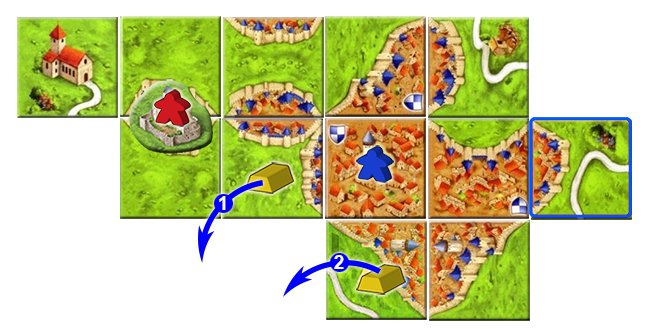 Voorbeeld 1B-2: Blauw bouwt haar stad af, wat de telling van de burcht van rood veroorzaakt. Als actieve speler lukt het blauw om beide goudstaven te pakken. Blauw neemt eerst de goudstaaf op het leengoed van de burcht (zowel rood als blauw mochten die pakken), zodat rood geen goudstaven kan pakken. Tenslotte pakt blauw de goudstaaf onderaan de stad.
Voorbeeld 1B-2: Blauw bouwt haar stad af, wat de telling van de burcht van rood veroorzaakt. Als actieve speler lukt het blauw om beide goudstaven te pakken. Blauw neemt eerst de goudstaaf op het leengoed van de burcht (zowel rood als blauw mochten die pakken), zodat rood geen goudstaven kan pakken. Tenslotte pakt blauw de goudstaaf onderaan de stad.
- Voorbeeld 2: De beste uitkomst onderzoeken
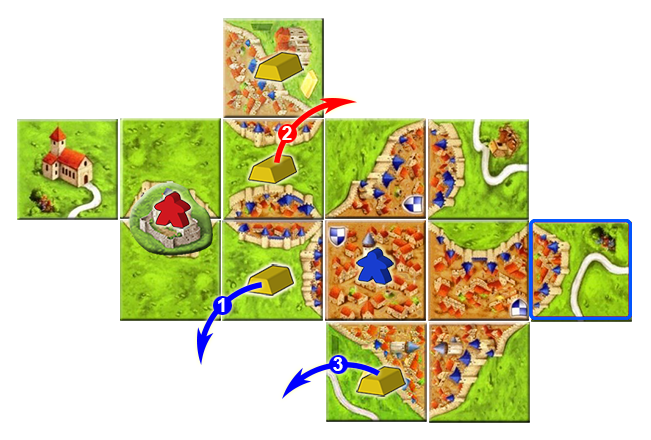 Voorbeeld 2A: Blauw bouwt haar stad af, waardoor de telling van de burcht van rood veroorzaakt wordt. Er liggen twee goudstaven in het leengoed van de burcht, waarvan er één op een tegel van de stad van blauw ligt. Als actieve speler besluit blauw om de goudstaaf op het leengoed van de burcht te pakken waar ook rood aanspraak op kan maken, zodat rood gedwongen wordt om de andere goudstaaf van het leengoed te pakken. Tot slot pakt blauw de goudstaaf onderaan de stad.
Voorbeeld 2A: Blauw bouwt haar stad af, waardoor de telling van de burcht van rood veroorzaakt wordt. Er liggen twee goudstaven in het leengoed van de burcht, waarvan er één op een tegel van de stad van blauw ligt. Als actieve speler besluit blauw om de goudstaaf op het leengoed van de burcht te pakken waar ook rood aanspraak op kan maken, zodat rood gedwongen wordt om de andere goudstaaf van het leengoed te pakken. Tot slot pakt blauw de goudstaaf onderaan de stad.
Blauw krijgt 2 goudstaven en rood krijgt één goudstaaf.
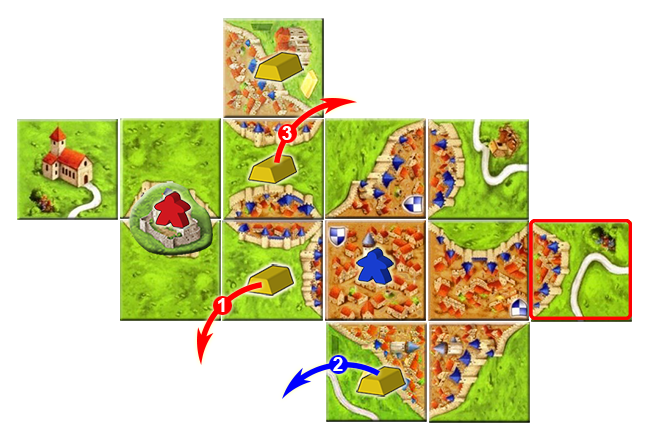 Voorbeeld 2B: Rood bouwt de stad van blauw af, wat de telling van de burcht van rood veroorzaakt. Er liggen twee goudstaven op het leengoed van de burcht, waarvan één op een tegel met een stadsdeel van de stad van blauw). Als actieve speler besluit rood de goudstaaf op het leengoed van de burcht te pakken waar ook blauw aanspraak op kan maken, zodat blauw gedwongen wordt om de goudstaaf onderaan de stad te pakken. Tot slot pakt rood de andere goudstaaf van het leengoed.
Voorbeeld 2B: Rood bouwt de stad van blauw af, wat de telling van de burcht van rood veroorzaakt. Er liggen twee goudstaven op het leengoed van de burcht, waarvan één op een tegel met een stadsdeel van de stad van blauw). Als actieve speler besluit rood de goudstaaf op het leengoed van de burcht te pakken waar ook blauw aanspraak op kan maken, zodat blauw gedwongen wordt om de goudstaaf onderaan de stad te pakken. Tot slot pakt rood de andere goudstaaf van het leengoed.
Blauw krijgt 1 goudstaaf en rood krijgt 2 goudstaven.
- Voorbeeld 3: De verdeling van goudstaven veroorzaken, maar er geen krijgen
- Bij het tellen van een burcht kan de eigenaar alleen aanspraak maken op goudstaven die op het leengoed van de burcht liggen, zelfs als ze niet op tegels liggen die bij het project horen dat de telling van de burcht heeft veroorzaakt.
- Voorbeeld 4: De projecten die de telling veroorzaakt hebben zijn niet van belang
- Voorbeeld 5: Reeks van gebeurtenissen waarbij het bouwen van een burcht betrokken is
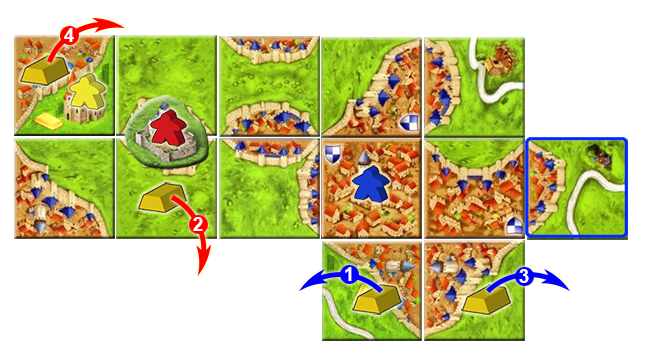 Voorbeeld 5.4: Blauw bouwt haar stad af, waardoor de telling van de burcht van rood veroorzaakt wordt. Blauw en rood pakken om de beurt goudstaven. Blauw zal de twee goudstaven onderaan de stad pakken en rood zal de twee goudstaven in het leengoed van de burcht pakken, ondanks dat die goudstaven niet op het project liggen dat de telling van de burcht veroorzaakte.
Voorbeeld 5.4: Blauw bouwt haar stad af, waardoor de telling van de burcht van rood veroorzaakt wordt. Blauw en rood pakken om de beurt goudstaven. Blauw zal de twee goudstaven onderaan de stad pakken en rood zal de twee goudstaven in het leengoed van de burcht pakken, ondanks dat die goudstaven niet op het project liggen dat de telling van de burcht veroorzaakte.
- Als een klooster in het leengoed van een burcht geteld wordt, kan de eigenaar ervan aanspraak maken op goudstaven die in de omgeving van het klooster liggen. De naastgelegen burcht kan alleen aanspraak maken op goudstaven in het leengoed van de burcht.
- Voorbeeld 6: Verkennen van de telling van een klooster dat het leengoed van een burcht overlapt
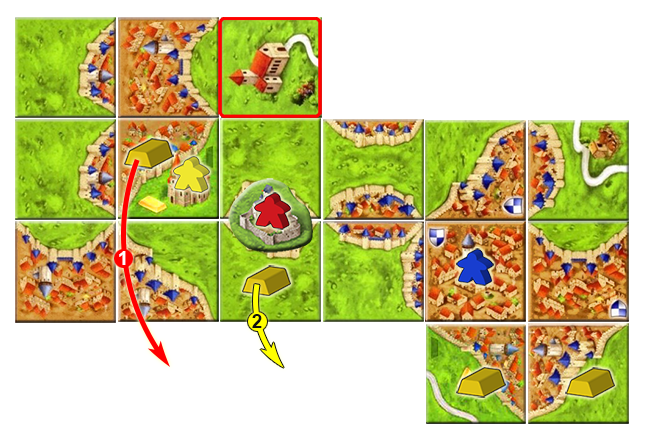 Voorbeeld 6-1: Rood bouwt het klooster van geel af, waardoor de telling van de burcht van rood veroorzaakt wordt. Rood en geel pakken elk één goudstaaf, ongeacht de volgorde waarin ze gekozen worden aangezien de twee goudstaven zowel in het leengoed van de burcht als de omgeving van het klooster (d.w.z. op de kloostertegel of een omliggende tegel) liggen.
Voorbeeld 6-1: Rood bouwt het klooster van geel af, waardoor de telling van de burcht van rood veroorzaakt wordt. Rood en geel pakken elk één goudstaaf, ongeacht de volgorde waarin ze gekozen worden aangezien de twee goudstaven zowel in het leengoed van de burcht als de omgeving van het klooster (d.w.z. op de kloostertegel of een omliggende tegel) liggen.
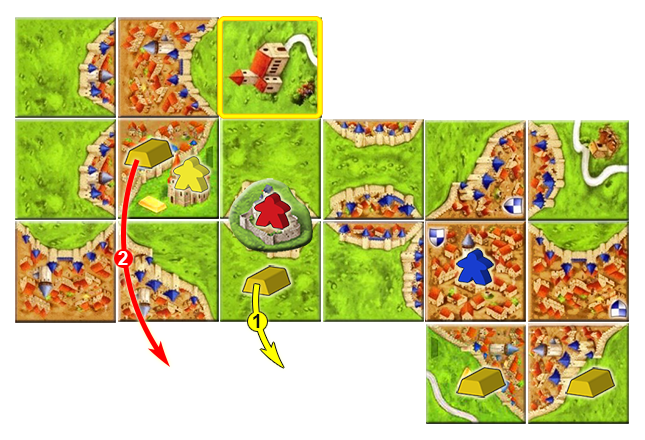 Voorbeeld 6-2: Geel bouwt haar klooster af, waardoor de telling van de burcht van rood veroorzaakt wordt. Geel en rood pakken elke één goudstaaf, ongeacht de volgorde waarin ze gekozen worden, aangezien de twee goudstaven zowel in het leengoed van de burcht als de omgeving van het klooster (d.w.z. de kloostertegel en de omgliggende tegels) liggen.
Voorbeeld 6-2: Geel bouwt haar klooster af, waardoor de telling van de burcht van rood veroorzaakt wordt. Geel en rood pakken elke één goudstaaf, ongeacht de volgorde waarin ze gekozen worden, aangezien de twee goudstaven zowel in het leengoed van de burcht als de omgeving van het klooster (d.w.z. de kloostertegel en de omgliggende tegels) liggen.
Tegelverdeling
C3 Editie
C2 Editie
Voetnoten
Kijk op de Pictogrammen pagina voor uitleg over en licensering van de pictogrammen.
- ↑
 Als een burcht afgebouwd wordt, krijgt de eigenaar de goudstaven op de 6 tegels die bij de burcht horen: de 2 tegels waar de burcht op gebouwd is, de 2 tegels links daarvan en de 2 tegels rechts ervan. De eigenaar van de burcht hoeft niet noodzakelijkerwijs recht te hebben op goud dat verbonden is aan het project dat het afbouwen van de burcht veroorzaakte (tenzij die goudstaaf ook in de omgeving van de burcht ligt, of de eigenaar van de burcht tevens de meerderheid heeft op het primaire project). (6/2013)
Als een burcht afgebouwd wordt, krijgt de eigenaar de goudstaven op de 6 tegels die bij de burcht horen: de 2 tegels waar de burcht op gebouwd is, de 2 tegels links daarvan en de 2 tegels rechts ervan. De eigenaar van de burcht hoeft niet noodzakelijkerwijs recht te hebben op goud dat verbonden is aan het project dat het afbouwen van de burcht veroorzaakte (tenzij die goudstaaf ook in de omgeving van de burcht ligt, of de eigenaar van de burcht tevens de meerderheid heeft op het primaire project). (6/2013)
- ↑
 Normaalgesproken, worden goudstaven die op tegels van afgebouwde projecten liggen verdeeld bij het tellen van het project. Afhankelijk van het project kan er een verschil zijn in de betrokken goudstaven:
Normaalgesproken, worden goudstaven die op tegels van afgebouwde projecten liggen verdeeld bij het tellen van het project. Afhankelijk van het project kan er een verschil zijn in de betrokken goudstaven:
- Projecten die alleen goudstaven op hun tegels verdelen:
- Wegen
- Steden
- Projecten die goudstaven verdelen van de projecttegel en de omliggende tegels:
- Kloosterachtige gebouwen: kloosters, abdijen, cultusplaatsen, Duitse kloosters (met een monnik), Nederlandse & Belgische kloosters (met een monnik), Japanse gebouwen (met een monnik), Darmstadtkerken
- Tuinen
- Baba Yaga's hut
- Duitse burchten
- Projecten die goudstaven verdelen van de projecttegel en van wegtegels die ermee verbonden zijn:
- Duitse kathedralen
- Projecten die goudstaven verdelen van de aan het project grenzende tegels:
- Burchten
- Projecten die alleen goudstaven op hun tegels verdelen:
- ↑
 Een consequentie van deze spelregels is dat goudstaven die op tegels liggen met afgebouwde projecten die geen eigenaar hebben niet verdeeld worden, aangezien er geen speler is die het project bezet.
Een consequentie van deze spelregels is dat goudstaven die op tegels liggen met afgebouwde projecten die geen eigenaar hebben niet verdeeld worden, aangezien er geen speler is die het project bezet.
- ↑
 In het algemeen, als er één of meer projecten betrokken zijn, kiest de speler die aan de beurt is (als deze recht heeft op goudstaven) als eerste een goudstaaf uit alle goudstaven waarop hij of zij recht kan doen gelden. De volgende speler (met de klok mee) die recht kan doen gelden op goudstaven mag daarna een goudstaaf kiezen. Merk op omdat een speler mag kiezen welke goudstaaf hij eerst neemt (als er meer dan één is om uit te kiezen), een andere speler die oorspronkelijk recht kon doen gelden op een goudstaaf achter het net kan vissen als die goudstaaf al is gepakt voordat die speler aan de beurt is om te kiezen. (6/2013)
In het algemeen, als er één of meer projecten betrokken zijn, kiest de speler die aan de beurt is (als deze recht heeft op goudstaven) als eerste een goudstaaf uit alle goudstaven waarop hij of zij recht kan doen gelden. De volgende speler (met de klok mee) die recht kan doen gelden op goudstaven mag daarna een goudstaaf kiezen. Merk op omdat een speler mag kiezen welke goudstaaf hij eerst neemt (als er meer dan één is om uit te kiezen), een andere speler die oorspronkelijk recht kon doen gelden op een goudstaaf achter het net kan vissen als die goudstaaf al is gepakt voordat die speler aan de beurt is om te kiezen. (6/2013)
- ↑
 Deze alinea is herschreven om het geval dat projecten bezet worden door verschillende spelers en die tegelijkertijd worden afgebouwd te omvatten. Hoewel wel beschreven door HiG, werd dig geval weggelaten door ZMG en dekte hun bewoording uitsluitend het geval dat er meerdere spelers de meerderheid deelden in één project.
Deze alinea is herschreven om het geval dat projecten bezet worden door verschillende spelers en die tegelijkertijd worden afgebouwd te omvatten. Hoewel wel beschreven door HiG, werd dig geval weggelaten door ZMG en dekte hun bewoording uitsluitend het geval dat er meerdere spelers de meerderheid deelden in één project.
- ↑
 Deze twee zinnen van HiG werden weggelaten door ZMG.
Deze twee zinnen van HiG werden weggelaten door ZMG.
- ↑
 Deze voorbeelden zijn gebaseerd op de verhelderingen die verschaft zijn door Kettlefish in de volgende gesprekken, volgnens de verheldering verschaft door Christof Tisch van 6/2013.
Deze voorbeelden zijn gebaseerd op de verhelderingen die verschaft zijn door Kettlefish in de volgende gesprekken, volgnens de verheldering verschaft door Christof Tisch van 6/2013.
- Carcassonne Central: https://www.carcassonnecentral.com/community/index.php?topic=279.0
- Carcassonne Forum: https://www.carcassonne-forum.de/viewtopic.php?f=101&t=886

